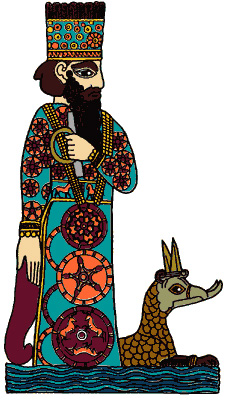
This symbol originally represented the Babylonian God “Marduk.” He was a Sun God and eventually became the primary or chief diety in later Babylonian times. He was also associated with brewing and was a Beer-Brewing God who had many symbols and fifty names. This one, believed to be the earliest symbol for beer and brewing, is a stylized tool used for spreading grain in the anicient brewing process. The rounded part was a handle and you spread the grain out to dry and evened it out using the flat blade at the upper left. It has also been described as a “sharp pick” or “pick-axe,” as well.

Here is the Wikipedia entry for Marduk:
Marduk’s original character is obscure, but whatever special traits Marduk may have had were overshadowed by the reflex of the political development through which the Euphrates valley passed and which led to imbuing him with traits belonging to gods who at an earlier period were recognized as the heads of the pantheon. There are more particularly two gods — Ea and Enlil — whose powers and attributes pass over to Marduk. In the case of Ea, the transfer proceeds pacifically and without involving the effacement of the older god. Marduk is viewed as the son of Ea. The father voluntarily recognizes the superiority of the son and hands over to him the control of humanity. This association of Marduk and Ea, while indicating primarily the passing of the supremacy once enjoyed by Eridu to Babylon as a religious and political centre, may also reflect an early dependence of Babylon upon Eridu, not necessarily of a political character but, in view of the spread of culture in the Euphrates valley from the south to the north, the recognition of Eridu as the older centre on the part of the younger one.
While the relationship between Ea and Marduk is marked by harmony and an amicable abdication on the part of the father in favour of his son, Marduk’s absorption of the power and prerogatives of Enlil of Nippur was at the expense of the latter’s prestige. After the days of Hammurabi, the cult of Marduk eclipsed that of Enlil; although Nippur and the cult of Enlil enjoyed a period of renaissance during the four centuries of Kassite control in Babylonia (c. 1570 BC – 1157 BC), the definite and permanent triumph of Marduk over Enlil became felt within the Babylonian empire. The only serious rival to Marduk after ca. 1000 BC was Anshar in Assyria. In the south, Marduk reigned supreme. He is normally referred to as Bel “Lord”.
When Babylon became the capital of Mesopotamia, the patron deity of Babylon was elevated to the level of supreme god. In order to explain how Marduk seized power, Enûma Elish was written, which tells the story of Marduk’s birth, heroic deeds and becoming the ruler of the gods. This can be viewed as a form of Mesopotamian apologetics. Also included in this document are the fifty names of Marduk.
In Enûma Elish, a civil war between the gods was growing to a climactic battle. The Anunnaki gods gathered together to find one god who could defeat the gods rising against them. Marduk, a very young god, answered the call and was promised the position of head god.
When he killed his enemy, he “wrested from him the Tablets of Destiny, wrongfully his” and assumed his new position. Under his reign humans were created to bear the burdens of life so the gods could be at leisure.
People were named after Marduk. For example, the Biblical personality, the Persian Mordechai (Book of Esther) used this Gentile name in replacement of his Hebrew name Bilshan.
Babylonian texts talk of the creation of Eridu by the god Marduk as the first city, ‘the holy city, the dwelling of their [the other gods] delight’.
In late Babylonian astrology, Marduk was connected to the planet Jupiter. As the ruler of the late Babylonian pantheon, he was equated with the Greek god Zeus (Latin Jupiter), hence the name of the planet.
I chose this symbol for the Beer Bulletin for at least three reasons.
- It was the earliest symbol used by mankind for brewing
- It’s a brewing implement
- My initials are J.B., and if you look closely it sort of looks like a stylized “B” (the handle) and an upside down “J” (the blade and crooked staff)

The logo was designed my friend Ken Hickmott, who is also the Art Director for the Celebrator Beer News. If you need graphics work of any kind done, he’s your man.
